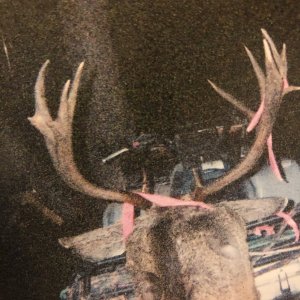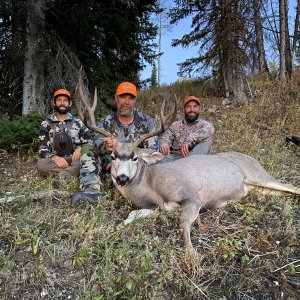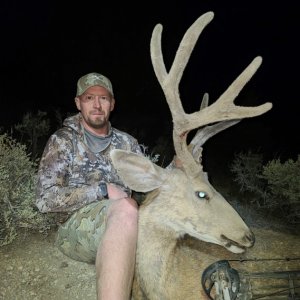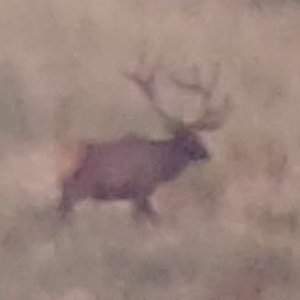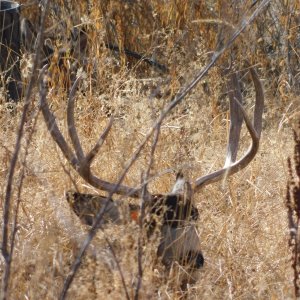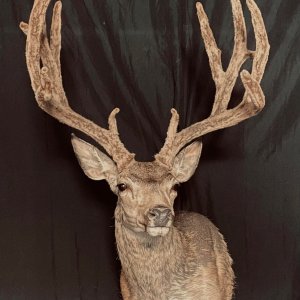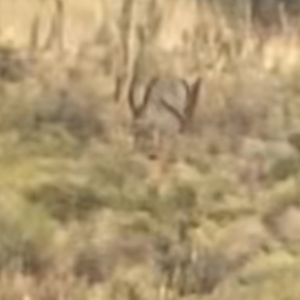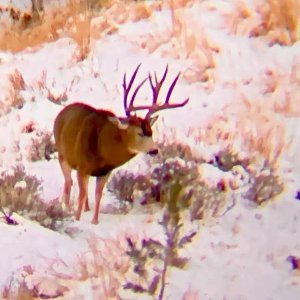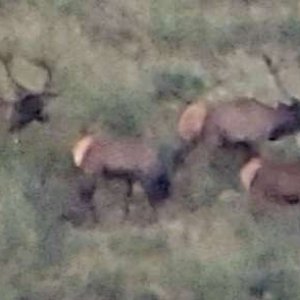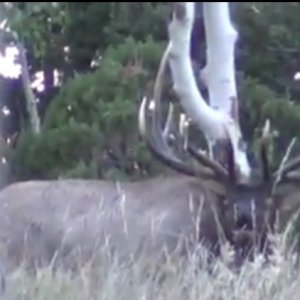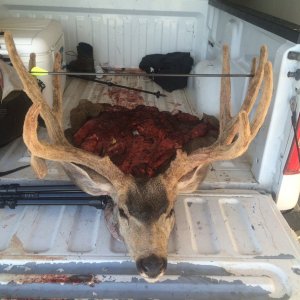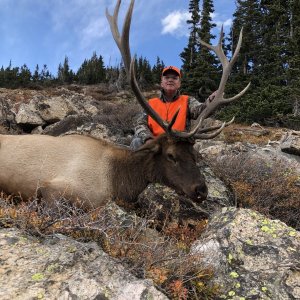Does anybody elese think they are way off on the buck to doe ratios in their reports. Looking at the unit I hunted last year, the ratio was supposed to be 40 bucks per 100, I would sure like to know where they got those numbers from because I don't think there was 100 deer on the whole mountain and 40 bucks per 100 is better than utah has on their very best units. I talked to about 30 or so other hunters and they had the exact same experience as we did. We hiked our butts off trying to find the deer. I knew other people that went out for the 4th season with the same experience. I just think they exaggerate there numbers to sell tags. It would be like utah publishing that they have 40 bucks per 100 in the general northern region. just my two cents
You are using an out of date browser. It may not display this or other websites correctly.
You should upgrade or use an alternative browser.
You should upgrade or use an alternative browser.
Colorado department of wildlife
- Thread starter armybrat
- Start date
Daxter
Very Active Member
- Messages
- 1,425
Colorado uses a very different method to estimate their buck to doe ratios than Utah. Colorado chooses a random block inside the unit (I think the size is 1 square mile, but it might be smaller?) and they fly a grid over the block in a helicopter and classify bucks and does. This block may be over private land or in an area that is not easily accessible to hunters which would give you a high buck to doe ratio. The sample size is pretty small and may not be representative of the entire unit.
In Utah, the buck to doe ratios are based on lots of classification data collected by the biologists, officers, and other folks that help out. They take all the classification data and average it for the unit, and then average the units for the region. Most of this data is collected from the road, and it is not random. Because there is no random element in the design, they try to get a very large sample size to overcome any biases. There is a graduate student at Utah State right now doing a pilot study using the method from CO in northern UT.
It is hard to compare estimates of buck to doe ratios from CO and UT because even though they supposedly represent the same thing, they are based on completely different methods. However, I am pretty sure that CO does have higher buck to doe ratios than UT. CO has approximately 600,000 deer and about 100,000 deer hunters, while UT has approximately 320,000 deer and about 100,000 deer hunters.
Good question, I had wondered about it myself.
Dax
In Utah, the buck to doe ratios are based on lots of classification data collected by the biologists, officers, and other folks that help out. They take all the classification data and average it for the unit, and then average the units for the region. Most of this data is collected from the road, and it is not random. Because there is no random element in the design, they try to get a very large sample size to overcome any biases. There is a graduate student at Utah State right now doing a pilot study using the method from CO in northern UT.
It is hard to compare estimates of buck to doe ratios from CO and UT because even though they supposedly represent the same thing, they are based on completely different methods. However, I am pretty sure that CO does have higher buck to doe ratios than UT. CO has approximately 600,000 deer and about 100,000 deer hunters, while UT has approximately 320,000 deer and about 100,000 deer hunters.
Good question, I had wondered about it myself.
Dax
cantkillathing
Very Active Member
- Messages
- 1,455
LAST EDITED ON Jul-26-07 AT 11:32AM (MST)[p]Dax,
I hate to ran on your parade about the way Utah does there count, I have had numerous talks with our local biologist and he said they do how you described Colorado. They take the winter range during the rut and count deer, and then if they counted 100 deer in a square mile they take the estimate of that 100, and then if winter range is 15 square miles they figure 1500 deer for the 15 square miles.
I might be wrong, but that is how it was explained to me, because I seen the deer count for the San Juan area and the numbers were rediculously high and when I asked the Biologist, he stated how they do it, and we argued, but nothing he can do about it. I am not lying when I say the numbers were extremely high. I would say that the numbers were 40-50% higher than what was really out there.
If my memory is right I think the report stated that between The Blue Mountains and Elk ridge there were supposed to be 11,000 deer, You cant even count 5,000 deer in san Juan county.
I bet you cant even count 3,000 deer in san juan county.
I hate to ran on your parade about the way Utah does there count, I have had numerous talks with our local biologist and he said they do how you described Colorado. They take the winter range during the rut and count deer, and then if they counted 100 deer in a square mile they take the estimate of that 100, and then if winter range is 15 square miles they figure 1500 deer for the 15 square miles.
I might be wrong, but that is how it was explained to me, because I seen the deer count for the San Juan area and the numbers were rediculously high and when I asked the Biologist, he stated how they do it, and we argued, but nothing he can do about it. I am not lying when I say the numbers were extremely high. I would say that the numbers were 40-50% higher than what was really out there.
If my memory is right I think the report stated that between The Blue Mountains and Elk ridge there were supposed to be 11,000 deer, You cant even count 5,000 deer in san Juan county.
I bet you cant even count 3,000 deer in san juan county.
OutdoorWriter
Long Time Member
- Messages
- 8,340
LAST EDITED ON Jul-26-07 AT 01:30PM (MST)[p]Game ratios, whether buck:doe or fawn:doe, are always expressed as XX:100, regardless of the actual number surveyed. It's done that way for uniformity and basically shows the PERCENT of one to the other, not the actual total numbers of deer in a given survey.
If they fly over three different parcels within a survey unit and count 50 does, 8 bucks and 25 fawns, the ratio will be shown as 16:100 (16%) for bucks-to-does and 50:100 (50%) for fawns to does.
This is better for comparison to other areas instead of using 8:50 and 25:50, then in the another area having something like 3:25 and 10:25, which would represent a count of 25 does, 3 bucks and 10 fawns. Expressed as common, the latter would be 12:100 (12%) and 40:100 (40%), i.e X4.
Obviously having the ratio expressed the same way each time makes the comparison a snap, without having to go through a math exercise each time. Just keep in mind that a buck to doe ratio of 20:100 might represent an actual deer count of 1 buck and 5 does X 20. -TONY
If they fly over three different parcels within a survey unit and count 50 does, 8 bucks and 25 fawns, the ratio will be shown as 16:100 (16%) for bucks-to-does and 50:100 (50%) for fawns to does.
This is better for comparison to other areas instead of using 8:50 and 25:50, then in the another area having something like 3:25 and 10:25, which would represent a count of 25 does, 3 bucks and 10 fawns. Expressed as common, the latter would be 12:100 (12%) and 40:100 (40%), i.e X4.
Obviously having the ratio expressed the same way each time makes the comparison a snap, without having to go through a math exercise each time. Just keep in mind that a buck to doe ratio of 20:100 might represent an actual deer count of 1 buck and 5 does X 20. -TONY
R
Rem308
Guest
I have hunted Colorado 21 times and have mostly enjoyed the hunting ,but the DOW and it's statistics is so far off base when they talk elk and deer population and harvest.
There counting practice is just a WAG {Wild -ss Guess} .Same way with there harvest statistics.I like hunting the state but there is to many hunters during the rifle seasons for me,archery or black powder is the only way to go.
There counting practice is just a WAG {Wild -ss Guess} .Same way with there harvest statistics.I like hunting the state but there is to many hunters during the rifle seasons for me,archery or black powder is the only way to go.
cabinfever
Very Active Member
- Messages
- 2,382
There was a post on this awhile back. Basically some hunters were calling BS on the cdows numbers so the cdow took an area and did actual counts and came out with slightly higher numbers. So the system has been proven....according to the CDOW Just because you are hunting an area and there are fewer bucks than what the cdow is representing doesn't mean the numbers are skewed. Some areas within a unit are completely void of deer while others have a ton of does while another area might have a lot of bucks. There is a unit I hunted in CO where I saw very few does during my hunt. Another factor to consider is the counts are done in January which means that you may have deer that summer in one unit and winter in another. I honestly don't pay any attention to those numbers because many of the biggest bucks in the state are coming from areas that have very low buck to doe ratios.
My 2 cents
My 2 cents
I call BS on the DOW's elk numbers. The say we have 250,000 elk with almost all of them west of I-25. With that many elk, I should be triping over them!!!
But it does make for good advertising to get the Nonresidents to come here and spend $500 on a tag that they have more than an 85% of not filling.
But it does make for good advertising to get the Nonresidents to come here and spend $500 on a tag that they have more than an 85% of not filling.
lostinOregon
Very Active Member
- Messages
- 2,006
I don't understand why anyone would complain about Colorado's deer herd/numbers. You should thank your lucky stars at what you have. I saw 24 4 point bucks by 11 on opening day of a 3rd season last year. I haven't seen 24 4 point bucks in Oregon in the last 10 years. I would say from what I saw and comparing that with there stats there buck to doe ratio was too low. I don't care what the buck to doe ratio is on paper, it is what I see when I'm hunting a unit. I would love to have the buck to doe ratios in my own home state to enjoy. I don't care if CDOW counts them in their own front yards, Colorado has awesome hunting.
Rich
Rich
Califelkslayer
Long Time Member
- Messages
- 4,078
I agree with Oregon. We hunt the 3rd largest elk herd in Colorado. I saw 250+ elk opening day of first rifle last year. This was hunting aspens where visibility was no more than 150 yards. All 8 of us saw over 100 elk that day. But we hunt aspen filled saddles/draws/funnel points and let the masses drive them to us. By the 3rd day of the 1st season, most of those elk run the timber instead of the aspens. Hunt these same areas opening day of 2nd season, you'd be lucky to see any elk. We took 10 elk (2 bulls/8cows) opening day last year, and 9 of 10 filled the year before (all cows) on opening day. We've filled 57 of our 59 tags since "01". That makes up for alot of guys that went home empty.
We've hunted the 2nd season and were lucky to fill 25% of our tags in the same areas but I bet there are some guys out there that have spots in the 2nd season where they have excellent sucess too.
We've hunted the 2nd season and were lucky to fill 25% of our tags in the same areas but I bet there are some guys out there that have spots in the 2nd season where they have excellent sucess too.
ICMDEER
Very Active Member
- Messages
- 2,994
I'm not sure I have this exactly straight, but Wyoming does it in a way that "fudges" the buck/doe ratio (in my estimation). They take the count after the season on the winter range here in Wyoming. They count bucks, does and fawns. The clinker is that G&F considers half of the fawns as bucks, since the buck fawns will be yearling bucks the following year (if they survive the winter and predators, etc)and as such, part of the huntable population of bucks.
So for example, they count 10 bucks, 100 does and 50 fawns in an area. Their buck doe ratio is 10 bucks plus half of the 50 fawns. So you add 10 bucks plus 25 buck fawns for a ratio of 35 bucks per 100 does. So in a way, they are projecting for the next year on an after-the-season count. There are only 10 2+ year old bucks in the population, but there are 25 that will be yearlings the following year. I think Colorado does it this way as well.
It does not make sense to me, but from a management perspective, this is how it is done in Wyoming.
I hope you can follow this. If not, shoot me a PM or reply here and I'll try to explain it better.
So for example, they count 10 bucks, 100 does and 50 fawns in an area. Their buck doe ratio is 10 bucks plus half of the 50 fawns. So you add 10 bucks plus 25 buck fawns for a ratio of 35 bucks per 100 does. So in a way, they are projecting for the next year on an after-the-season count. There are only 10 2+ year old bucks in the population, but there are 25 that will be yearlings the following year. I think Colorado does it this way as well.
It does not make sense to me, but from a management perspective, this is how it is done in Wyoming.
I hope you can follow this. If not, shoot me a PM or reply here and I'll try to explain it better.
OutdoorWriter
Long Time Member
- Messages
- 8,340
LAST EDITED ON Jul-27-07 AT 12:38PM (MST)[p]Most states usually do their game counts post-winter and after all hunts are concluded.
Now, I'm not sure about WY, but here in AZ the buck-to-doe ratio from the January surveys that are used for the FALL HUNT recommendations are based ONLY on the actual bucks counted to the actual does counted. NO FAWNS are included.
That said, if biologists are attempting to predict POPULATION estimates by sex -- not set hunt recommendations -- for the following fall, they will assume 50% of the fawns are bucks because that is the way it GENERALLY works out. So it can be a bit like the apples and oranges thingie; the key is what the counts are being used for.
Also realize those fawns counted in the winter are from the previous year, so they will actually be about 15-17 months old when the fall hunting season rolls around. So in reality, the upcoming spring crop of fawns will be additional to the survey counts but not counted until the following January. -TONY
Now, I'm not sure about WY, but here in AZ the buck-to-doe ratio from the January surveys that are used for the FALL HUNT recommendations are based ONLY on the actual bucks counted to the actual does counted. NO FAWNS are included.
That said, if biologists are attempting to predict POPULATION estimates by sex -- not set hunt recommendations -- for the following fall, they will assume 50% of the fawns are bucks because that is the way it GENERALLY works out. So it can be a bit like the apples and oranges thingie; the key is what the counts are being used for.
Also realize those fawns counted in the winter are from the previous year, so they will actually be about 15-17 months old when the fall hunting season rolls around. So in reality, the upcoming spring crop of fawns will be additional to the survey counts but not counted until the following January. -TONY
T
tmbrlinewarden
Guest
LAST EDITED ON Jul-28-07 AT 00:53AM (MST)[p]
Outdoor writer has a great handle on this. the original post may have been correct- (that there weren't 100 deer in the whole unit,) the 40:100 may have meant they counted 14 adult deer and 4 of them were bucks. At a certain point The lower the deer numbers, the more likley the ratios will be up higher. Fawns should never be counted towards buck:doe ratios. I'm not sure why anyone or any state would be inclined to do that, they are the one's setting the harvest, so why try and "fool yourself". Dont forget, if they add half of the fawns to the bucks, they have to add half of them to the does too (it still doesnt make any sense- they cannot count on all those fawns to be alive next year, and the number that will varies greatly) Again Outdoor writer is correct, the biologists may likly look at the # fawn bucks towards setting an age class. That age class curve (in the drop off in fawn, yearling, 2-1/2, 3-1/2 and so on CAN be used to accurately derive population size.
None of us have enough time on this forum to try and get into how population estimates are derived. Many of you guys have touched on a lot of good points about different methods used, but they've all been kind of oversimplified to the point that they're inaccurate and misleading. My guess is most states derive pop. estimates very similarly using a variety of methods and you guys are just coming at it from different angles. I've had many folks here in NM call into question pop estimates that I've help come up using survey methods and sightability index's that I help create- and I've long ago learned not to get my feelings hurt over it. We've been able in those area to predict almost exactly how many elk we were going to count and our ratios as we dropped an elk herd from 6000 down to 3000 over 5 years. (and subsequently had the landowners change their gripe and realize they need the elk back) Some times all of us tend to have a hard time viewing things beyond our own line of sight. I don't even know what unit this post started out talking about, but there are a hundred possible reasons why the CDOW's data is not obviously seen by hunters in that particular area- and 99 of them don't involve some sort of smoke and mirrors by DOW.
Having said that, 40:100 does seem high for a large population of deer unless it's extremely limited harvest, or it's having other serious issues (with the adult does). Or there are a lot of private ranches in the unit that tend to manage for 40-60 bucks 100 does) if they can.
100 does) if they can.

http://www.naweoa.org/mod.php?mod=userpage&page_id=15&menu=1500
Outdoor writer has a great handle on this. the original post may have been correct- (that there weren't 100 deer in the whole unit,) the 40:100 may have meant they counted 14 adult deer and 4 of them were bucks. At a certain point The lower the deer numbers, the more likley the ratios will be up higher. Fawns should never be counted towards buck:doe ratios. I'm not sure why anyone or any state would be inclined to do that, they are the one's setting the harvest, so why try and "fool yourself". Dont forget, if they add half of the fawns to the bucks, they have to add half of them to the does too (it still doesnt make any sense- they cannot count on all those fawns to be alive next year, and the number that will varies greatly) Again Outdoor writer is correct, the biologists may likly look at the # fawn bucks towards setting an age class. That age class curve (in the drop off in fawn, yearling, 2-1/2, 3-1/2 and so on CAN be used to accurately derive population size.
None of us have enough time on this forum to try and get into how population estimates are derived. Many of you guys have touched on a lot of good points about different methods used, but they've all been kind of oversimplified to the point that they're inaccurate and misleading. My guess is most states derive pop. estimates very similarly using a variety of methods and you guys are just coming at it from different angles. I've had many folks here in NM call into question pop estimates that I've help come up using survey methods and sightability index's that I help create- and I've long ago learned not to get my feelings hurt over it. We've been able in those area to predict almost exactly how many elk we were going to count and our ratios as we dropped an elk herd from 6000 down to 3000 over 5 years. (and subsequently had the landowners change their gripe and realize they need the elk back) Some times all of us tend to have a hard time viewing things beyond our own line of sight. I don't even know what unit this post started out talking about, but there are a hundred possible reasons why the CDOW's data is not obviously seen by hunters in that particular area- and 99 of them don't involve some sort of smoke and mirrors by DOW.
Having said that, 40:100 does seem high for a large population of deer unless it's extremely limited harvest, or it's having other serious issues (with the adult does). Or there are a lot of private ranches in the unit that tend to manage for 40-60 bucks

http://www.naweoa.org/mod.php?mod=userpage&page_id=15&menu=1500
Daxter
Very Active Member
- Messages
- 1,425
LAST EDITED ON Jul-28-07 AT 10:40AM (MST)[p]The methods I described for how UT and CO estimate their buck to doe ratios ARE what both of those states are currently using.
You also have to remember, as it has been pointed out, this is a ratio or percent and doesn't have anything to do with the total number of deer on a unit.
As far as population estimation goes, most states use the best feasible science to come up with their estimates. Do a Google search for Gary White and population estimation and see how many results you get. Dr. White is probably one of the leading scientists in estimating wildlife populations. He developed a widely used software program called POP2 for modeling wildlife populations. Several western states (including UT and CO) use variations of his methods for estimating deer populations.
Someone made mention of a study in which the public didn't believe the numbers estimated by the state of CO. In that case CDOW formed a committee and involved the sportsmen in the development of the population estimation method, but the sportsmen still didn't believe, so the sportsmen hired an independent consulting firm to come up with an estimate. The consulting firm came up with an estimate which was higher than CDOW's original estimate. Sportsmen still refused to believe either estimate. Here is a link to an abstract of that article:
( http://links.jstor.org/sici?sici=0091-7648(200423)32%3A3%3C916%3AHMMDAT%3E2.0.CO%3B2-5 )
How Many Mule Deer Are There? Challenges of Credibility in Colorado
Freddy, et al. Wildlife Society Bulletin, Vol. 32, No. 3 (Autumn, 2004), pp. 916-927
Wildlife management is based on science and data as much as possible. Often there is incomplete or inconclusive data, and important decisions have to be made based on professional opinions, intuition, or a gut feeling. But, when actual numbers are available, state wildlife agencies use the data.
I strongly doubt that WY is including half of the fawns in their post season buck to doe ratios. You ought to call the Game and Fish and ask if their post season buck to doe ratios include that years fawns, I would be money they do not. I would, however, believe that WY is counting half of the surviving fawns as bucks for next year in the model that they use to estimate population size.
Dax
You also have to remember, as it has been pointed out, this is a ratio or percent and doesn't have anything to do with the total number of deer on a unit.
As far as population estimation goes, most states use the best feasible science to come up with their estimates. Do a Google search for Gary White and population estimation and see how many results you get. Dr. White is probably one of the leading scientists in estimating wildlife populations. He developed a widely used software program called POP2 for modeling wildlife populations. Several western states (including UT and CO) use variations of his methods for estimating deer populations.
Someone made mention of a study in which the public didn't believe the numbers estimated by the state of CO. In that case CDOW formed a committee and involved the sportsmen in the development of the population estimation method, but the sportsmen still didn't believe, so the sportsmen hired an independent consulting firm to come up with an estimate. The consulting firm came up with an estimate which was higher than CDOW's original estimate. Sportsmen still refused to believe either estimate. Here is a link to an abstract of that article:
( http://links.jstor.org/sici?sici=0091-7648(200423)32%3A3%3C916%3AHMMDAT%3E2.0.CO%3B2-5 )
How Many Mule Deer Are There? Challenges of Credibility in Colorado
Freddy, et al. Wildlife Society Bulletin, Vol. 32, No. 3 (Autumn, 2004), pp. 916-927
Wildlife management is based on science and data as much as possible. Often there is incomplete or inconclusive data, and important decisions have to be made based on professional opinions, intuition, or a gut feeling. But, when actual numbers are available, state wildlife agencies use the data.
I strongly doubt that WY is including half of the fawns in their post season buck to doe ratios. You ought to call the Game and Fish and ask if their post season buck to doe ratios include that years fawns, I would be money they do not. I would, however, believe that WY is counting half of the surviving fawns as bucks for next year in the model that they use to estimate population size.
Dax
Most western states use a version of POP models that were 1st developed in CO 20 years or so ago. For example, NV currently uses a variation of POP4. Also many states do deer composition counts twice a year. The 1st during the rut or just after to get the fawn/doe ratio and the buck/doe ratio. Then they do another in late spring just before deer migrate to their summer range. This provides a fawn/doe ratio and is used to measure over winter loss. To use the POP models you have to know the post-season buck/doe and the preseason buck/oe ratio. The pre season buck/doe ratio is where the previous years fawns are added. There are whole books written on determining big game wildlife populations and whole books written on sampling techniques to determine wildlife populations. The statistics behind both are mind numbing.
from the "Heartland of Wyoming"
from the "Heartland of Wyoming"
Similar threads
- Replies
- 33
- Views
- 2k

